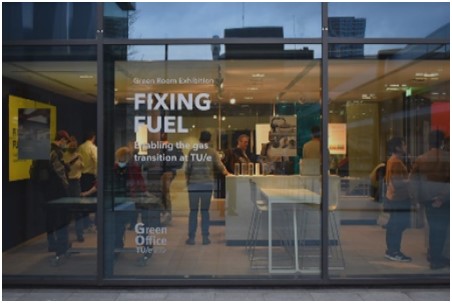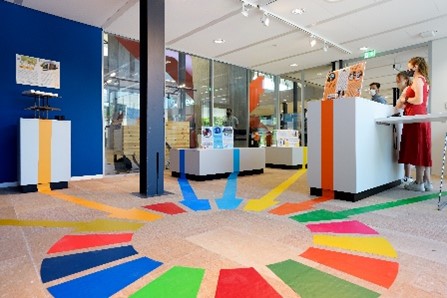A project or activity turns into a best practice when links between transformative education, research, governance and operations are optimally used and people and resources interact at every level. This page shows an overview of best practice examples that we have developed over the past years.
Best Practice 'Food Impact Calculation System (FICS)'
For an Innovation Space Project, a team of 4 students teamed up with our Sustainability Ambassador, Facility Management Services and our caterer Appèl to come up with a solution to nudge people to make a sustainable choice in the canteens at the TU/e.
The problem:
As climate change is coming closer to our own doorstep, we have realized that we need to do something about emissions in every industry. The food industry accounts for 37% of the global CO2 emission. However, people don’t want to be told what to do and how to behave, they want to make these choices for themselves. Our system changes the decision-making process for customers and caterers and makes the sustainable choice the easiest choice.
The solution:
The team came up with an idea for Food Labels that provides the necessary information to make the right choices, the social hero and the environmental fighter.
The social hero shows how well a product does when it comes to vitality, social responsibility and local harvest, while the environmental fighter considers emissions, water and organic production, and each product would get a score based on these topics. With our labels, it has been proven that 20% of the customers consciously goes for a low emission product.
This project consists of a scientifically approved method, being part of an educational assignment (as part of an existing course) which is tested in real life on campus. A perfect example of how Research, Education and Operational Management can work together to make the world a better place and reach goals as stated in the TU/e’s Sustainability Vision for Operational Management.
See this article in Cursor for more information: https://www.cursor.tue.nl/en/news/2021/december/week-2/how-sustainable-is-your-sandwich/
WHAT'S NEXT?
The test results were positive and asked for a follow up. What happened next is that a formal Student Team is formed around this subject, where the aim will be to improve the labelling system and implement it at all canteens at the TU/e and later create a possible industry standard, including a business model around the labels.
Best Practice 'Green Room, Atlas Building'
In 2019 our new, super sustainable, Atlas Building was re-opened, the main building of the TU/e campus where the Service Departments, the Board and some faculties are seated. On the ground floor of this building, a room was specifically dedicated to the GO Green Office (GGO). Instead of just becoming another standard meeting room, the GGO decided that this room needed to become the sustainability hub of the TU/e, latter dubbed "The Green Room".
Purpose
The purpose of the Green Room is twofold:
- To have a physical space for the Green Room to represent the TU/e when it comes to sustainability, innovation and technology.
- The Green Room is a physical and virtual place to connect the sustainability community so they can interact, connect and learn from each other. The Sustainability Hub will have a key role in connecting the sustainability community at the TU/e, as it will be used as a meeting place and as a place where you can exhibit what you work on.
What we created at the opening in 2021 is exactly what we envisioned, a place that connects research, education and the services on sustainability matters, a place where people meet and connect, where brainstorms are being held and a place that inspires and where people can freely wander in if it’s not in use.
Exhibitions
We’ve had two different professionally organized exhibitions:
- The first exhibition was on the SDG’s and how the TU/e helps to achieve those goals.
- The second exhibition was a collaboration with EIRES (research), GO Green Office and ELC, on how the TU/e helps to enable the transition from natural gas.
Other activities
We organized Movie Nights, we use it as our meeting room, etc. Thanks to this room, several people met and teamed up and organized other events like the (digital, thanks to corona) meetup with Milieudefensie, the COP26 Event (also online thanks to corona).
Best Practice ‘Dynka Living Lab TU/e (Energy and wellbeing)'
How do you improve the health and well-being of employees while reducing energy consumption at the same time? With DYNKA we focus on both aspects. To what extent the right combination of LED light and temperature can reduce energy consumption in the field of heating or cooling, is being investigated. The influence of this on the perception of health (alertness, sleep-wake rhythm, comfort, metabolism, temperature & perception) among employees is also examined.
The DYNKA research is part of a collaborative project between Eindhoven University of Technology (TU/e), Maastricht University (UM), Huygen Installatie Adviseurs, Hogeschool Zuyd, Almende, Signify, Knowledge Institute ISSO and Kropman Installatietechniek. The research is being conducted by researchers from TU/e and UM. The project is financed by TKI Urban Energy of the Ministry of Economic Affairs.
Best Practice ‘Kernteam Vital Campus (social Duurzaamheid en vitaliteit)’
The vitality core team started drawing up the Vital Campus plan during the vitality week (19 - 23 November 2018). During this week, a diverse mix of more than 100 stakeholders came together for a healthy breakfast brainstorming session to provide input and create a project plan to become one of the healthiest campuses in the world.
Why? Enabling and encouraging students and staff to follow healthy lifestyles creates a vibrant campus culture of compassion, well-being, equality and social engagement.
Read the annual report of 2018 – 2019 about everything the Vitaly Core team has done
Roadshow Polymer Membrane
The roadshow Polymer Membranes shows two interesting projects from the research of the group Membrane Materials and Processes (MM/P). Kitty Nijmeijer and Zandrie Borneman manage some fifteen applied research projects that focuses on the creation, characterization, and application of membranes for a variety of applications.
The roadshow started on 27 September, 2019, during Momentum in the hall of Auditorium and traveled during more then a year over the campus. It consists of two flat 'íce cream' carts that imitate the processes of Clean water and Blue Energy. Animations explain the proces.
What is a membrane?
A membrane is a filter with small pores that let some of the substances through and others not. It looks like a straw. The term membrane is derived partly from the French membrane (web in a plant / thin smooth skin around organs) and partly from the Latin membrana (thin skin, membrane, parchment), a derivation of membrum (part of the body). MM/P creates them in all kind of shapes and sizes, depended from the necessary application.
Clean water
Using membranes to produce potable water from ground water. You can even drink the purified water! MM/P is doing research into the application of polymeric membranes in water to purify waste water and re-use of water. The emphasis strongly lies on waste water, recovery of valuable components in water and re-use of waste water. Membranes are used widespread for decades in water treatment installations.
Blue energy
A striking project the group has undertaken is Blue Energy. In this, electricity is generated by bringing fresh river water and salty seawater in contact with each other through a membrane. The membrane allows in this case no water, but salt ions to diffuse into the fresh water from the salt sea water. And the movement of electrically charged ions creates an electric current. 'Blue energy' centers on the boundary between fresh and salt water (such as estuaries) could potentially cover the world more than 10% of global electricity demand. For several years there is a little 'blue' power plant on the Afsluitdijk (in 2016 declared National Icon) and there are plans for a ten times larger plant at Katwijk, with a capacity of 1 megawatt. That is sufficient energy for about sixteen hundred households.
Read the article in Cursor.
Check out more about the membrane research.
Roadshow Solar Energy
The popularity of solar energy has been on the rise for years. Thanks to continuous research, the efficiency of solar cells is rising and the costs are also decreasing. TU/e technology is being used in almost one third of all solar cells worldwide. Erwin Kessels and the research group Plasma and Materials Processing (PMP) are conducting research into increasing the efficiency and efficiency of solar cells. The researchers' mission is clear and they are fully committed to this. In 2018 the roadshow took place wason the TU/e campus in which this research was central.
Check the video Solar Energy research.
Business case Living Lab
This business case describes the need, cost and benefits for a central TU/e Living Labs platform to collect data from and use of (IoT) sensors (in our Living Labs).
Best Practice ‘Red Team’
A number of student teams are directly involved in the CO2 reduction on our campus, especially Team Red offers concrete solutions. They have a working product with which TU/e can calculate possible CO2 saving measures in real time.


